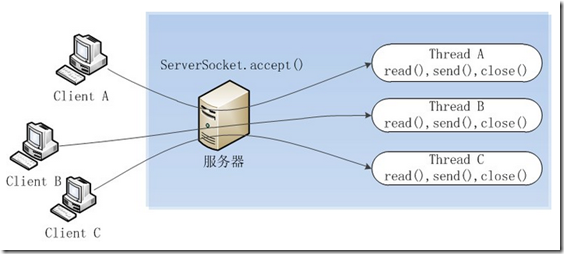Java NIO和阻塞IO的区别:
阻塞I/O在调用InputStream.read()方法时是阻塞的,它会一直等到数据到来时(或超时)才会返回;同样,在调用ServerSocket.accept()方法时,也会一直阻塞到有客户端连接才会返回,每个客户端连接过来后,服务端都会启动一个线程去处理该客户端的请求。
阻塞I/O的缺点:
- 1. 当客户端多时,会创建大量的处理线程。且每个线程都要占用栈空间和一些CPU时间
2. 阻塞可能带来平凡的上下文切换,且大部分上下文切换可能是无意义的。 - Java NIO是在jdk1.4开始使用的,它既可以说成“新I/O”,也可以说成非阻塞式I/O。下面是java NIO的工作原理:
1. 由一个专门的线程来处理所有的 IO 事件,并负责分发。
2. 事件驱动机制:事件到的时候触发,而不是同步的去监视事件。
3. 线程通讯:线程之间通过 wait,notify 等方式通讯。保证每次上下文切换都是有意义的。减少无谓的进程切换。
以代码为例:
服务端代码
package cn.nio; import java.io.IOException; import java.net.InetSocketAddress; import java.nio.ByteBuffer; import java.nio.channels.SelectionKey; import java.nio.channels.Selector; import java.nio.channels.ServerSocketChannel; import java.nio.channels.SocketChannel; import java.util.Iterator; /** * NIO服务端 * @author 小路 */ public class NIOServer { //通道管理器 private Selector selector; /** * 获得一个ServerSocket通道,并对该通道做一些初始化的工作 * @param port 绑定的端口号 * @throws IOException */ public void initServer(int port) throws IOException { // 获得一个ServerSocket通道 ServerSocketChannel serverChannel = ServerSocketChannel.open(); // 设置通道为非阻塞 serverChannel.configureBlocking(false); // 将该通道对应的ServerSocket绑定到port端口 serverChannel.socket().bind(new InetSocketAddress(port)); // 获得一个通道管理器 this.selector = Selector.open(); //将通道管理器和该通道绑定,并为该通道注册SelectionKey.OP_ACCEPT事件,注册该事件后, //当该事件到达时,selector.select()会返回,如果该事件没到达selector.select()会一直阻塞。 serverChannel.register(selector, SelectionKey.OP_ACCEPT); } /** * 采用轮询的方式监听selector上是否有需要处理的事件,如果有,则进行处理 * @throws IOException */ @SuppressWarnings("unchecked") public void listen() throws IOException { System.out.println("服务端启动成功!"); // 轮询访问selector while (true) { //当注册的事件到达时,方法返回;否则,该方法会一直阻塞 selector.select(); // 获得selector中选中的项的迭代器,选中的项为注册的事件 Iterator ite = this.selector.selectedKeys().iterator(); while (ite.hasNext()) { SelectionKey key = (SelectionKey) ite.next(); // 删除已选的key,以防重复处理 ite.remove(); // 客户端请求连接事件 if (key.isAcceptable()) { ServerSocketChannel server = (ServerSocketChannel) key .channel(); // 获得和客户端连接的通道 SocketChannel channel = server.accept(); // 设置成非阻塞 channel.configureBlocking(false); //在这里可以给客户端发送信息哦 channel.write(ByteBuffer.wrap(new String("向客户端发送了一条信息").getBytes())); //在和客户端连接成功之后,为了可以接收到客户端的信息,需要给通道设置读的权限。 channel.register(this.selector, SelectionKey.OP_READ); // 获得了可读的事件 } else if (key.isReadable()) { read(key); } } } } /** * 处理读取客户端发来的信息 的事件 * @param key * @throws IOException */ public void read(SelectionKey key) throws IOException{ // 服务器可读取消息:得到事件发生的Socket通道 SocketChannel channel = (SocketChannel) key.channel(); // 创建读取的缓冲区 ByteBuffer buffer = ByteBuffer.allocate(10); channel.read(buffer); byte[] data = buffer.array(); String msg = new String(data).trim(); System.out.println("服务端收到信息:"+msg); ByteBuffer outBuffer = ByteBuffer.wrap(msg.getBytes()); channel.write(outBuffer);// 将消息回送给客户端 } /** * 启动服务端测试 * @throws IOException */ public static void main(String[] args) throws IOException { NIOServer server = new NIOServer(); server.initServer(8000); server.listen(); } }
客户端代码:
package cn.nio; import java.io.IOException; import java.net.InetSocketAddress; import java.nio.ByteBuffer; import java.nio.channels.SelectionKey; import java.nio.channels.Selector; import java.nio.channels.SocketChannel; import java.util.Iterator; /** * NIO客户端 * @author 小路 */ public class NIOClient { //通道管理器 private Selector selector; /** * 获得一个Socket通道,并对该通道做一些初始化的工作 * @param ip 连接的服务器的ip * @param port 连接的服务器的端口号 * @throws IOException */ public void initClient(String ip,int port) throws IOException { // 获得一个Socket通道 SocketChannel channel = SocketChannel.open(); // 设置通道为非阻塞 channel.configureBlocking(false); // 获得一个通道管理器 this.selector = Selector.open(); // 客户端连接服务器,其实方法执行并没有实现连接,需要在listen()方法中调 //用channel.finishConnect();才能完成连接 channel.connect(new InetSocketAddress(ip,port)); //将通道管理器和该通道绑定,并为该通道注册SelectionKey.OP_CONNECT事件,注册该事件后, //当该事件到达时,selector.select()会返回,如果该事件没到达selector.select()会一直阻塞。 channel.register(selector, SelectionKey.OP_CONNECT); } /** * 采用轮询的方式监听selector上是否有需要处理的事件,如果有,则进行处理 * @throws IOException */ @SuppressWarnings("unchecked") public void listen() throws IOException { // 轮询访问selector while (true) { // 选择一组可以进行I/O操作的事件,放在selector中,该方法会阻塞 selector.select(); // 获得selector中选中的项的迭代器 Iterator ite = this.selector.selectedKeys().iterator(); while (ite.hasNext()) { SelectionKey key = (SelectionKey) ite.next(); // 删除已选的key,以防重复处理 ite.remove(); // 连接事件发生 if (key.isConnectable()) { SocketChannel channel = (SocketChannel) key .channel(); // 如果正在连接,则完成连接 if(channel.isConnectionPending()){ channel.finishConnect(); } // 设置成非阻塞 channel.configureBlocking(false); //在这里可以给服务端发送信息哦 channel.write(ByteBuffer.wrap(new String("向服务端发送了一条信息").getBytes())); //在和服务端连接成功之后,为了可以接收到服务端的信息,需要给通道设置读的权限。 channel.register(this.selector, SelectionKey.OP_READ); // 获得了可读的事件 } else if (key.isReadable()) { read(key); } } } } /** * 处理读取服务端发来的信息 的事件 * @param key * @throws IOException */ public void read(SelectionKey key) throws IOException{ //和服务端的read方法一样 } /** * 启动客户端测试 * @throws IOException */ public static void main(String[] args) throws IOException { NIOClient client = new NIOClient(); client.initClient("localhost",8000); client.listen(); } }
